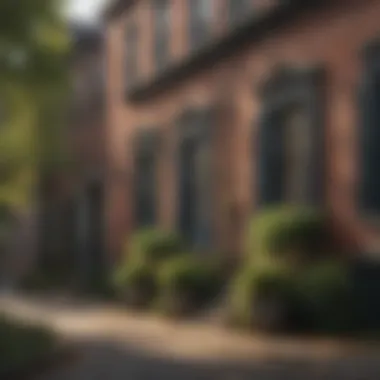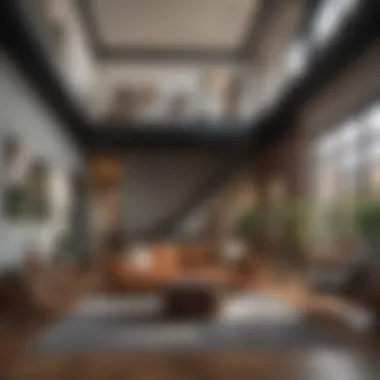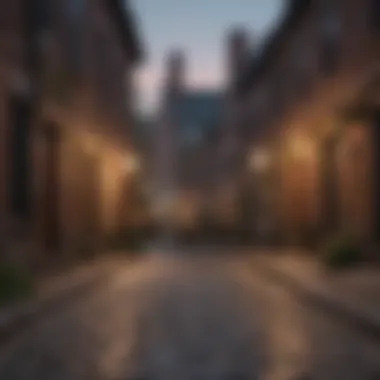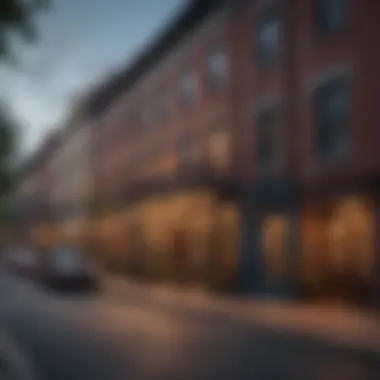Exploring the Unique Homes of Old City Philadelphia


Intro
Old City Philadelphia stands as a treasure trove of historical architecture and vibrant culture. This neighborhood offers a unique tapestry woven from various design styles and rich stories that echo through its cobbled streets. Exploring homes in Old City is not just about the buildings; it is about understanding the essence of a place that has evolved yet retains its core identity.
The significance of homes in this area cannot be overstated. Each residence tells a tale of its past, while also catering to the modern living needs of its inhabitants. Whether one is a real estate enthusiast, travel lover, or interior design aficionado, Old City invites exploration and appreciation.
In the following sections, we will walk through the artistic influences that shape the architectural landscape of Old City. We will also touch upon the evolving interior design trends that reflect contemporary ambitions while respecting the historical footprint.
Ultimately, this guide aims to illuminate the intricate relationship between historic preservation and modern lifestyle, providing a comprehensive overview of the opportunities and challenges present in Old City Philadelphia.
Historical Overview of Old City Philadelphia
Understanding the historical significance of Old City Philadelphia is crucial for any discussion about homes in this area. This neighborhood serves as a living testament to America's early history, showcasing the evolution of American architecture and urban life. The neighborhoods here encapsulate the interwoven narratives of commerce, culture, and community that shaped Philadelphia into a pivotal city.
The examination of this history provides insight into how architectural styles and urban planning have developed over time. It also highlights the impact of various historical events on residential life. By studying Old City, one can appreciate the layers of history that influence current real estate trends and community dynamics.
Foundation and Early Development
Old City Philadelphia was founded in 1682 by William Penn, who envisioned a city based on principles of religious freedom and tolerance. The layout reflected a grid pattern, which was innovative for its time, allowing for organized development. The proximity to the Delaware River facilitated trade and commerce, positioning Philadelphia as an essential port city.
As settlers built homes, diverse architectural styles began to emerge. Early structures aimed for practicality yet displayed craftsmanship. They used local materials, leading to a distinct aesthetic that resonates to this day. This early development set the stage for a rich architectural tapestry that would evolve over the centuries.
Architectural Evolution Over the Centuries
The architecture of Old City is a narrative of change and adaptation. From Colonial homes with their symmetry and simple designs to later Federal styles boasting more elaborate details, the neighborhood showcases a variety of influences. In the 19th century, Victorian styles emerged, bringing ornate decorations and unique layouts.
Each architectural phase reflects broader societal changes—industrial growth, cultural shifts, and urbanization. Modern influences now coexist with historic structures, creating a dynamic urban landscape. Architects have worked diligently to preserve the unique character of Old City homes while also adapting them for contemporary needs.
Significant Historical Landmarks
Several landmarks in Old City Philadelphia stand out and merit attention. The Liberty Bell and Independence Hall are not just significant as national symbols; they also reshape the narrative around residential choices in the area. These sites attract tourists, which affects local real estate demand and property values.
Moreover, historic buildings like the Powel House and the Carpenters' Hall represent the rich history of the city. These structures provide context for understanding the homes in the surrounding areas. Visitors and residents alike can engage with this history, fostering a sense of community rooted in shared heritage.
"Old City isn't just a place to live; it's a repository of stories and architectural wonders that breathe life into every corner."
Each of these elements contributes to the character of Old City. The rich historical context enhances the appeal of living here, offering residents a unique blend of past and present.
Architectural Styles in Old City
The architectural styles found in Old City, Philadelphia, play a pivotal role in understanding the character and identity of the area. Each style encapsulates a period of history and presents unique aesthetic features. They also reflect the community’s evolving needs and preferences over time. When exploring homes in Old City, awareness of these styles allows potential homeowners and enthusiasts to appreciate the design principles and craftsmanship involved.
Colonial and Federal Styles
The Colonial and Federal styles dominate the landscape of Old City, originating in the 17th and 18th centuries. Colonial architecture is marked by symmetry and simple forms. It often features brick or wood siding, gable roofs, and double-hung windows. The Federal style, which evolved after the Colonial period, introduced more decorative elements. Characteristics include fanlight windows, elegant doorways, and refined detailing. These styles not only showcase the craftsmanship of that time but also provide aesthetic continuity in the neighborhood.
Potential homeowners should consider that these historical homes often have issues related to modernization. Restoration of these homes can require a delicate balance, maintaining historical integrity while updating certain amenities.
Victorian Influences
Victorian architecture emerged in the 19th century and is distinct for its elaborate design. This style incorporates various elements such as intricate woodwork, bay windows, and decorative trims. In Old City, you may see Gothic Revival, Italianate, and Second Empire influences. Each Victorian home tells its own story through its unique ornamentation and layout. It is the diversity of these influences that contributes to the eclectic charm of Old City.
Homebuyers attracted to the Victorian aesthetic often prioritize character over convenience. It’s essential to recognize the maintenance costs associated with such properties, as preserving historical features can be more labor-intensive.
Modern Adaptations


As times change, so do the architectural needs of residents. Modern adaptations in Old City reflect a blend of contemporary design with historical elements. Many developers have embraced the challenge of incorporating modern utilities while respecting the historical guidelines set forth in Old City. This fusion can be seen in loft-style apartments created from former warehouses, featuring open floor plans and large windows.
Contemporary homeowners benefit from energy-efficient technologies and updated building codes. However, they must remain aware of the implications of living in a historic district. Adhering to preservation standards can dictate how substantially one can alter a property.
"Understanding the architectural styles in Old City not only enriches one’s appreciation of the homes but also informs the decisions of those looking to invest in this historic area."
In summary, the architectural styles of Old City Philadelphia serve as a window into its past and present. Each style tells its own story, offering unique benefits and considerations for potential residents. Engaging with these styles deepens the connection to the community and enhances the experience of living in this historically rich area.
Real Estate Landscape
The real estate landscape in Old City Philadelphia plays an essential role in understanding the area’s charm and appeal for potential homeowners. This aspect touches upon various elements, including property types, pricing trends, and neighborhood dynamics. With a rich history and vibrant culture, this area showcases a blend of historic and modern properties, giving it a unique character. The real estate opportunities here can attract both investors and individuals seeking a distinctive living environment.
Current Market Trends
The current market trends reflect increased interest in urban living, especially in historically rich neighborhoods like Old City. Prices have seen fluctuations in recent years, partially influenced by economic conditions and interest rates. The demand for properties is often high, indicating a bustling market.
Some significant observations include:
- Price Growth: Recent years have seen a notable rise in property values, encouraging homeowners to invest.
- Short Supply: Limited availability of homes leads to competitive bidding scenarios.
- Diverse Buyers: A mix of young professionals and retirees are exploring the residential options within this area.
Investors might find opportunities in various formats, as residential units can often become lucrative short-term rentals due to the neighborhood's rich history, attracting tourists year-round.
Types of Residences Available
Old City offers an array of residential options, catering to different preferences and lifestyles. These include:
- Condos and Lofts: Ideal for those valuing modern amenities combined with historic charm. These spaces often feature exposed brick and open floor plans.
- Townhouses: Many of these properties are restored historic structures, providing a glimpse into the past while offering contemporary living.
- Single-Family Homes: These are less common but provide a more traditional residential experience. Space and privacy are beneficial for families or those looking for more room.
Each type of residence has its appeal and can serve diverse demographics, from singles to families.
Investment Opportunities
Investing in Old City holds promise for discerning buyers. The location's appeal and constant flux of new residents support a strong rental market. Key points to consider include:
- Historic Tax Credits: Owners of historic property can benefit financially when undertaking renovations, making investing here more accessible.
- Tourism and Rental Income: Given the area's significance, short-term rentals are lucrative, allowing homeowners to generate substantial income.
- Future Development: As urban areas continue to evolve, new developments are anticipated, potentially increasing property values over time.
Understanding these investment opportunities is vital for anyone considering real estate in this historic part of Philadelphia, as they may yield significant returns.
Living in Old City
Living in Old City Philadelphia offers a unique experience characterized by a blend of rich history and vibrant modernity. The neighborhood is not just a place to reside; it is an area that embodies culture, diversity, and community. Understanding the specific elements and benefits of living here can enhance one's appreciation of this iconic setting. Residents often enjoy easy access to historic streets, cultural institutions, and local marketplaces, which contribute to a lively lifestyle. As such, this section discusses the community dynamics, amenities, and recreational options available to residents in Old City.
Community and Neighborhood Dynamics
The community in Old City is a tapestry of diverse individuals and groups. Residents come from various backgrounds, each contributing to the rich cultural milieu that defines the area. This diversity creates a social fabric where interactions are frequent and often welcoming. The sense of belonging is tangible here. Many residents regularly participate in neighborhood events, fostering strong interpersonal relationships. This engagement is important, especially for newcomers who wish to integrate into the fabric of the community.
Moreover, Old City is known for its historic significance, which influences community pride. Many residents appreciate the preservation efforts aimed at maintaining the character of the streets and buildings. The neighborhood is home to both long-term residents and newer arrivals, making for an interesting blend of perspectives. As the city evolves, community dynamics also shift, but the spirit of collaboration among different groups remains strong.
Local Amenities and Services
Living in Old City means having access to a wealth of local amenities and services. From grocery stores to coffee shops, the neighborhood caters to the daily needs of its residents. Some notable establishments include:
- Reading Terminal Market: A bustling hub that features a variety of fresh produce, meats, and artisanal foods.
- Target: Provides a convenient shopping experience for household essentials.
- Bakeries and Cafés: Numerous options exist for those who enjoy local brews and pastries. Popular spots often have their regulars.
In terms of health and wellness, there are several options for fitness enthusiasts, including gyms and parks for outdoor activities. Accessibility to essential services like banks, post offices, and medical facilities enhances the quality of life for residents.


Cultural and Recreational Spaces
Old City is rich in cultural and recreational resources that provide both entertainment and enrichment. Key spots include
- Independence Hall: A UNESCO World Heritage Site that offers guided tours.
- The Pennsylvania Academy of the Fine Arts: Famous for its impressive collection of American art.
- Parks and Public Spaces: Several parks are within walking distance, offering relaxation and green space amidst the urban setting.
Residents often take advantage of local galleries, theaters, and art shows. This cultural vibrancy not only enhances daily living but also fosters a sense of identity among those who call Old City home.
"Living in Old City is like having a front-row seat to history while enjoying all the conveniences of modern life."
Overall, living in Old City Philadelphia is characterized by a nexus of community, convenience, and culture. The interplay of historic and contemporary elements makes this area a noteworthy place for both individuals and families.
Challenges of Urban Living
Urban living in Old City Philadelphia presents a unique set of challenges that potential residents must navigate. Understanding these challenges is essential for anyone considering a move to this historic neighborhood. The allure of charming architecture and vibrant culture can often be overshadowed by practical realities.
Preservation vs. Development
The tension between preservation and development in Old City is notable. Historic homes and buildings are integral to the neighborhood's identity. However, there is a constant need for modernization to meet current living standards and demands. Property owners face the challenge of balancing these two forces. Development can lead to larger dwellings that attract new residents but often at the expense of historical integrity. A careful approach is required to maintain the charm while adapting to contemporary needs.
Residents and stakeholders frequently engage in discussions around zoning laws and preservation efforts. This dialogue is vital as it influences future urban planning decisions. It is important to consider how additions or renovations can be designed to blend with existing structures while also offering modern amenities.
Noise and Congestion Issues
Living in an urban setting often means dealing with noise and traffic congestion. Old City, being a hub for nightlife and tourism, experiences higher than average foot and vehicle traffic during peak hours. This can lead to disturbances, especially at night.
Residents may find that noise levels affect their daily routines and overall comfort. Street sounds, including construction or late-night activities, can be disruptive. Furthermore, allocated parking can be scarce, making it challenging for those who own a vehicle.
Addressing these issues requires awareness and adaptability. Some residents may choose to embrace the dynamic environment, while others might seek solutions such as soundproofing or living further from the busiest areas.
Affordability and Gentrification
Affordability is another pressing issue in Old City. The desirable location and cultural richness have led to rising property prices, pushing some long-time residents out. Gentrification can bring about improvements in local infrastructure and services, but it also raises significant concerns.
Long-standing neighborhoods often feel the impact of new buyers who can afford higher rents and home prices. This change can erode the cultural fabric of the community. It is important to acknowledge the contributions of existing residents and find ways to integrate new developments sensitively.
According to real estate experts, the intersection of affordability and gentrification requires strategic planning to ensure that current residents are not displaced by new developments.
Sustainability and Modern Upgrades
Sustainability is becoming a crucial focus in urban environments, including Old City Philadelphia. As residents seek to balance modern living with a respect for historical integrity, incorporating sustainable practices into home design and renovation becomes essential. This section will explore different aspects of sustainability in Old City, highlighting methods, challenges, and benefits of modern upgrades in historic homes.
Incorporating Eco-Friendly Practices
The integration of eco-friendly practices in Old City can take many forms. Homeowners are increasingly turning to renewable energy sources, such as solar panels. Installing these systems not only reduces dependence on fossil fuels but also lowers electricity costs over time. Beyond energy generation, green roofs can be installed. They help with insulation and provide space for gardens, enhancing urban biodiversity.
Moreover, water conservation methods, such as rainwater harvesting systems, are gaining traction. These practices not only support sustainability but also contribute to the historic charm of neighborhoods. It is important to work with specialists familiar with the area's specific architectural needs to ensure that changes do not compromise historical aesthetics.
Renovation Challenges in Historic Homes
Renovating historic homes is inherently complex. Builders must navigate a web of regulations designed to protect these structures. For instance, many homes in Old City are subject to strict preservation guidelines that dictate what alterations can be made. This can limit the types of eco-friendly upgrades. Finding the right balance between updating infrastructure and adhering to preservation standards often requires creative thinking and collaboration with local heritage organizations.
Furthermore, older homes may have foundational issues or outdated electrical systems, presenting a considerable challenge for modern energy efficiency. Upgrading insulation while maintaining the character of the space often leads to higher renovation costs and extended timelines. Homeowners must evaluate whether the energy efficiency gained justifies these expenses.
Benefits of Modern Living Adjustments


Despite the challenges, the benefits of modern upgrades can be significant. Sustainable renovations often lead to reduced utility bills, a selling point for potential buyers. Homes that feature energy-efficient upgrades appeal more to a society that values environmental responsibility.
Additionally, modern living adjustments can improve the comfort and quality of life within these historic homes. Improved insulation and energy-efficient windows not only minimize energy loss but also enhance interior comfort.
In summary, the combination of sustainability and modern upgrades can breathe new life into the historic fabric of Old City Philadelphia. Homeowners who embrace these principles contribute not only to their comfort but to the wider community, ensuring that Old City retains its unique character while evolving with modern needs.
"Balancing the need for sustainable practices with the desire to preserve historical integrity is essential for the future of Old City homes."
By integrating eco-friendly practices, navigating renovation challenges, and reaping the benefits of modern adjustments, homeowners can create spaces that promote sustainability without losing touch with the rich history that defines Old City Philadelphia.
Personal Stories from Residents
Personal stories from residents serve as a significant thread in understanding the essence of living in Old City Philadelphia. Individual experiences provide depth to the architectural and historical observations made in earlier sections. These narratives highlight the human connections to the area, offering genuine insight that statistics and historical data often overlook.
When exploring homes, considering the stories of people who reside in them brings a vibrant understanding to their environments. For potential homeowners and design enthusiasts, these accounts can underscore qualities such as community bonds, neighborhood culture, and the practical realities of daily life in Old City. The shared experiences of individuals create a richer tapestry, illustrating the uniqueness of this historic locale.
Voices of Diverse Homeowners
The residential landscape of Old City is a mosaic of diverse homeowners. Each voice contributes a unique perspective shaped by personal backgrounds and life experiences. Some residents have lived in historical homes that preserve elements of the past, while others have adapted modern spaces infused with contemporary design.
- Cultural diversity: Homeowners come from various cultural backgrounds, adding to the vibrancy of the neighborhood. This diversity fosters an inclusive environment that invites new ideas and traditions.
- Personal transformations: For many, the choice to live in Old City was not simply about residence but about lifestyle. From artists to professionals, each individual finds inspiration in the architectural beauty and historical significance enveloping them.
- Community contributions: Residents often engage in community projects, from local art initiatives to neighborhood clean-ups, underscoring a shared commitment to enhancing their surroundings.
Stories of how individuals connect with each other and their environment amplify the charm of Old City.
Experiences of Long-Term Residents
Long-term residents possess a wealth of knowledge about Old City’s evolution. Their experiences offer valuable insights into changes over the years, regarding both the community atmosphere and the housing market.
- Historical changes: Many long-time homeowners recount how areas have transformed over decades, illustrating shifts in real estate trends and neighborhood dynamics. The feeling of community has evolved but remains strong for those who have settled here.
- Enduring neighborhoods: Long-term residents often describe a sense of stability that comes with having deep roots. They have witnessed generations flourish amidst the historic backdrop, creating lasting memories that further enrich the locale.
- Tips for newcomers: Their stories often encompass advice for individuals moving in, from engaging with local groups to exploring nearby amenities. This guide can be invaluable for newcomers seeking to integrate into the community.
Insights from Newcomers
Newcomers provide fresh perspectives and invigorating energy to Old City. Their experiences can shed light on the transition into this historic neighborhood and the complexities of modern urban living.
- First impressions: New residents often speak about the immediate allure of Old City’s architectural beauty and vibrant lifestyle. Their narratives reflect the initial appeal that draws them in, along with their passion for discovering the area's hidden gems.
- Adaptation journeys: The transition to living in a historic district can come with challenges, from navigating older home maintenance to adapting to the city's pace. Newcomers often share their stories of adaptation and resilience in the face of these challenges.
- Community integration: Many newcomers discuss the efforts made to connect with long-time residents and how these relationships enrich their lives. The blending of old and new fosters a dynamic community atmosphere, making Old City a harmonious place to live.
"Living in Old City has been a blend of discovery and learning. It's not just about the buildings, it's about the people and their shared stories that make this place home."
The combination of reflections from diverse homeowners, long-term residents, and newcomers creates a multi-dimensional view of life in Old City Philadelphia. Such personal accounts not only highlight the significance of place but also the relevance of community in shaping individual experiences.
Future Outlook for Old City Philadelphia
The future of Old City Philadelphia presents a fascinating synthesis of historical preservation and contemporary growth. As urban landscapes evolve, understanding these dynamics becomes pertinent for various stakeholders, particularly homebuyers and urban planners. With its rich architectural heritage, Old City faces the challenge of balancing modern demands with its unique historical context. Anticipating how this interplay unfolds is essential for those looking to invest or reside in the area.
Predicted Development Trends
Current trends in urban development suggest a move toward increased density and sustainability within Old City. The need for residential spaces has led to the repurposing of older buildings, transforming warehouses and factories into chic lofts and apartments. This trend not only preserves historical architecture but also meets the growing demand for housing among young professionals. New residential projects are increasingly focused on eco-friendly designs, offering energy-efficient options that meet contemporary standards.
Future construction may also include mixed-use developments. These spaces blend commercial and residential sections, fostering community interaction and vibrant street life. Factors like walkability and proximity to public transport are becoming more appealing to potential residents.
Impact of Virtual Work Environments
The rise of remote work is reshaping how and where people choose to live. Old City can capitalize on this shift as more individuals seek out homes that offer quality of life along with accessibility to urban amenities. The flexibility of remote working opens the door for people to reside in neighborhoods like Old City without the constraints of daily commutes.
This change also influences housing preferences. Homes that provide suitable workspaces, such as cozy nooks or dedicated offices, will likely be in higher demand. Developers are responding by integrating work-friendly environments into design, catering to this professional demographic seeking balance between work and leisure.
Cultural Preservation in Future Designs
As development progresses, the importance of cultural preservation cannot be overstated. Residents and city planners must collaborate to ensure that modern additions respect and enhance the historical fabric of Old City. This consideration is critical in retaining the neighborhood’s identity while evolving its character.
Future designs should reflect the architectural language of the area, utilizing materials and styles that resonate with local history. Integrating modern technological advancements while showcasing historic elements not only serves to honor the past but enhances the overall living experience.
"Sustainable practices in design do not only honor the past; they create a future that aligns with community values."







